




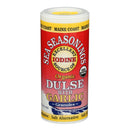
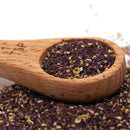
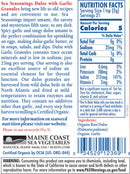
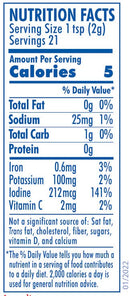
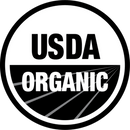
Description
Dried seaweed is a nutritional powerhouse. Sea vegetables are known to contain most, if not all, of the 24 minerals and trace elements required for your body's physiological functions, some in quantities greatly exceeding those of land plants. They contain significant levels of vitamins, including the B vitamins, Vitamin A, and Vitamin C. Their protein content ranges from 10% to almost 40%, and they contain all or most of the essential amino acids required by humans. They’re low in fat and high in fiber; two qualities that make them healthy for the heart. And then, of course, there’s iodine. Sea vegetables are one of the highest natural sources of dietary iodine, even when eaten in small quantities.
Below are two tables showing levels of selected nutrients found in our eight species of whole leaf sea vegetable, seaweed blends, and in Kelp Krunch. Milled sea vegetables have the same nutritional composition as the whole leaf from which they were milled. For example, dulse flakes have the same nutritional composition as whole leaf dulse. The levels in these tables are provided as “amounts per 100g” because this is how the information is normally presented for food industry specifications. It also makes it easier to compare levels between species and products. You can use this table to calculate how much of any specific nutrient you're getting in a specific serving size. All you need is a calculator and a simple formula: divide the level of the nutrient found in the nutrients per 100g table by 100 to get the level per gram, and then multiply by the number of grams in your serving. Just remember, it's impossible to know the exact level of any nutrient in sea vegetables because nutrients vary between season, age, location, and other factors. Also, 100 grams is not a serving size! Serving sizes of sea vegetables are much smaller than that. If you scroll down the page past the tables you will find more information on serving size, as well as on specific nutrients.
The levels provided in these tables represent average compositions determined through various published research articles and our own testing. For some species there’s no published data for certain nutrients and we have not yet tested for those nutrients. When that’s the case, it’s indicated by “ND” (No Data). Also, it’s important to keep in mind that sea vegetables are wild marine plants, and their nutritional composition is known to vary due to naturally occurring fluctuations in the plants. These fluctuations may be due to location, season, tidal flows, ocean temperatures, weather patterns, and other factors. The values presented here are not absolutes, and we believe the whole plants provide more than the sum of their parts. (You may double click on the table in order to view larger.)
Seaweed Nutritional Facts By Species


Serving Size
To paraphrase an old saying, oftentimes good things come in small portions. This is definitely true of sea vegetables. You don’t have to eat a lot to get the most of their flavor and nutrition. Even in Japan, where about one-third of the adult population eats seaweed almost every day, the average daily intake is only about 4-7 grams, usually over the course of 2-3 small servings eaten throughout the day. In the US, the FDA defines a serving size as the amount of food customarily consumed (i.e., typically eaten) in one sitting for that food. The FDA often refers to serving size as the “Reference Amount Customarily Consumed”, or RACC. The serving size is required information on nutrition facts labeling because it informs consumers about the nutritional value of their food in a quantifiable fashion. The serving size shouldn’t be interpreted as the amount one is supposed to eat, but rather as the amount that most people ordinarily eat. For dried edible seaweed, the FDA considers 5g to be the RACC.
The below table shows the serving size for most Maine Coast Sea Vegetable products, along with levels of the three essential minerals required on the nutrition label, plus iodine (nutritional values are rounded to nearest whole number). You’ll see that the serving size for some of our milled products is smaller than the FDA RACC of 5 grams for seaweed, whereas for whole leaf products it’s larger. We’ve learned through experience and from our customers that how much people eat very much depends on the product form and how it’s used. Sea vegetable flakes, granules and powders are usually used in small amounts to add flavor and nutrition to such things as soups, dips, or smoothies. Whole leaf sea vegetables, on the other hand, may be eaten as snacks or used as ingredients in salads or casseroles, much as one might add arugula or other greens to a mixed salad, or spinach to a lasagna.
Typical Sea Vegetable Serving Sizes Showing Essential Minerals and Iodine Per Serving

We ship to every US state and territory as well as Canada. We do not ship anywhere else at this current time.
In the contiguous US, we offer free shipping on orders over $50.
For orders under $15 there is a $5 shipping fee.
For orders between $15 and $50 there is a $10 shipping fee.
For other states, territories and Canada see below.
We only ship from our facility in Hancock, Maine. Most orders will be processed within two business days of receiving them. If you are in the continental US, you can expect to receive your order within 3 to 10 business days after processing. We'll send you an email with a tracking number on the day your package leaves our warehouse.
Please note that holidays or weather may affect shipping times.
The map below shows estimated delivery times from our location using UPS ground. Orders usually leave our facility by 2pm Monday-Friday.

Shipping to Alaska, Hawaii, and US Territories
For orders outside of the contiguous US, there will be a $10.00 shipping and handling fee.
We typically use the US Postal Service for deliveries to Alaska, Hawaii, and other US Territories. At this time we have been noticing longer shipping times through the USPS to these areas. Please be patient.
Shipping to Canada:
There will be a $25.00 shipping and handling fee for all orders to Canada.
Keep in mind that any duties or import taxes charged by customs are the responsibility of the customer, we can't calculate them before shipment.
International Purchases
For international purchases, you can find a selection of our products on iHerb.com
Shipping internationally by a freight forwarder:
Maine Coast Sea Vegetables will not be responsible for any damage or loss that happens to orders after they are received by a freight forwarder. We can only provide a replacement or refund for goods that are damaged in transit to the freight forwarder. If this is the case, we will need photos and documentation from the freight forwarder so we can place a claim with the carrier (either USPS or UPS).CANCELLATIONS AND ORDER CHANGES
Cancellations must be made within 24 hours of the original order.
If you need to change your order, you can create a second order and we'll cancel the original one.
Alternatively, you can contact us and we'll edit the original order and send you a link to update your payment.
WHERE'S MY PACKAGE?
Please understand once an item is shipped, it is the responsibility of the carrier to deliver packages on time and without damage. Please review USPS or UPS shipping policy.
- Please be patient and track your package.
- If tracking information shows the package was delivered but you do not have it, check with neighbors and your local carrier before contacting us.
- If the package cannot be located, a minimum of 15 days must have passed (from expected delivery date) before we can consider a refund, reship or file a claim.
- We cannot file a claim until enough time has passed, you've contacted your carrier, then you've contacted us, and we've contacted the carrier, and they declare the package is truly lost.
WHAT CARRIERS DO YOU USE?
We ship UPS or USPS at our discretion, offering both package tracking and reliable delivery.
We MUST have a street address to ship UPS
PO Boxes default ship to USPS.
Please email us a note, including your name and order number, if your location requires one type of shipping
PACKAGING MATERIALS
We use environmentally friendly materials, such as recycled craft packing paper and reusable cardboard boxes.
RETURNS AND REFUNDS
Please see Refunds Page for more information.
Why We Test
What We Test For
Microbes
Our products are regularly screened for total bacterial counts; coliform bacteria and pathogenic E. coli; foodborne pathogens such as Salmonella and Staphylococcus aureus; and mold & yeasts. Microbial testing is done throughout the year to meet food safety requirements. In over 30 years of testing we have never detected any of the common foodborne pathogens. This is mainly because dried sea vegetables contain natural sea salts and very little moisture, making them inhospitable for bacterial growth and giving them an extended shelf life. However, like other raw natural foods, dried seaweed is not entirely sterile, and if it's rehydrated it should be kept refrigerated during and after reconstitution. Occasionally, we get questions from customers wondering if their seaweed has mold on it. Usually, it turns out to be precipitated salts and sugars. Our FAQs and this downloadable document titled "Moldy Seaweed" provide more information on this topic.

Pesticides/Herbicides
Widely used in agriculture and by property owners, these compounds are of concern because they can appear as residues on foods. We use a screening protocol endorsed by the USDA National Organic Program (NOP) for ensuring produce meets the ‘certified organic’ standard for pesticide and herbicide residues. This testing is done annually by us and at random by our certifying agency (OCIA); our test results are posted below as NOP panel.
Petroleum Residues
Tested as Polycyclic Aromatic Hydrocarbons (PAHs). This screen verifies our seaweed is free of gasoline and oil combustion residues coming from surface runoff or boats. This testing is done annually and the results are posted below as PAH's.
Heavy Metals
Our labs use gas chromatography and mass spectrometry to detect and quantify trace levels (<1 part per million) of cadmium, lead, mercury, and inorganic forms of arsenic in our seaweed. These elements are widely distributed in the world’s oceans from both natural and human sources. This testing is done annually and the results along with more detail on heavy metals in seaweed are posted below. Test results are for a single test done on a composite sample incorporating up to eight different lots for each product/species.
Radioactivity
Following the 2011 Fukushima nuclear catastrophe, customers became concerned that even seaweed as far away from the disaster as Maine could have become contaminated, and we’ve been annually testing ever since. Test results can be found below.
How We Test
Testing is done every winter after the harvest has been dried and stored. We take care to collect composite samples representative of each species, growing area, and form (leaf or milled). We don’t test every single batch or product each year, but we do test a representative of every species and growing area. For example, we may test dulse flakes but not powdered dulse, because the two products come from the same species and area. In this case, test results for dulse flakes can be applied to the powdered form.
Testing is done through accredited third-party labs. It’s important to understand the nature and substance of seaweed to accurately analyze it. Our contract labs use analytical methods refined over many decades by scientists from around the world, and they're validated by the EPA, FDA and global certification organizations before being approved for food testing. We work closely with our testing labs to remain current with the latest changes and refinements to test methods. Some of our testing labs include: Katahdin Analytical, Northeast Laboratories, Brooks Applied Labs, and eurofins.
Disclaimer
Seaweed is a traditional whole food that's been eaten by people around the world for many thousands of years with healthy results. However, every person is unique and we are unable to predict your body's response. There may be elements of these plants not suitable for your particular biochemistry or condition. Only you can determine what's best for you, in consultation with your healthcare practitioner. The seaweeds we sell are wild harvested, uncultivated marine algae. Naturally occurring fluctuations in the sea plants occur due to season, climate, tidal flow and time of harvest. The information we present on this website is believed to be accurate and reliable, but the testing is not carried out by Maine Coast Sea Vegetables and it is not guaranteed as a condition of sale. Maine Coast Sea Vegetables makes no warranty, either express or implied, and assumes no liability for this information or the products described.
Table of 2023-24 Test Results
ND= Not Detected above method detection limit or 0.01 ppm; ppm = parts per million, equivalent to micrograms per gram, or milligrams per kilogram
Heavy Metals in Seaweed
Customers sometimes ask why we test our Certified Organic sea vegetables for heavy metals, or why some products bear a "Proposition 65" warning about lead and cadmium. The reason for both is that as seaweed absorbs minerals from the ocean that are essential for human health, it also absorbs certain heavy metals that can harm human health. Testing helps both us and our customers make informed choices to safeguard health.
Minerals and elements, including heavy metals, are widely distributed throughout the world's oceans from natural processes such as weathering of the earth’s crust and atmospheric deposition, as well as from human industrial activity. Our seaweed comes from remote and wild areas far from big cities and industry, and Organic Certification ensures it isn't harvested near local sources of contamination such as boat marinas or municipal outfalls. However, because heavy metals are so ubiquitous in the environment, Organic Certification alone doesn't guarantee purity for seaweed or any other food.
Annual testing helps us determine whether products require a California Proposition 65 warning, and posting the data on our website helps our customers make informed choices. Scientists have studied the topic of heavy metals in seaweed for many years, and our assessment is that the numerous health and nutrition benefits of sea vegetables far outweigh the risk posed by the low levels of heavy metals they contain. However, we respect that others, for personal health reasons, may feel otherwise. This is why we test and post the results. For more information on this topic, please see the Heavy Metals FAQ in the section about environmental concerns.
Radioactivity Testing in Seaweed
We started testing seaweed for radioactivity in 2011 in response to the Fukushima, Japan nuclear catastrophe, and we haven't stopped since. Humans have released radiation into the environment, whether intentionally or accidentally, ever since the US first tested atomic bombs in 1945. Because eating seaweed offers some protection from radiation, it’s important to ensure the seaweed itself is free of harmful radioactive isotopes. This topic is further addressed in our FAQs.
The lab of Professor Thomas Hess, University of Maine Department of Physics, tested our seaweed every year from 2011 to 2019. In 2020 we moved to using a commercial lab for this testing. Test results are given as Bq per kg, which is a measure of the activity of a radioactive isotope. Japanese standards for acceptable activity levels in food and water, which are among the strictest in the world, call for less than 100 Bq/kg in general foodstuffs and less than 10 Bq/kg in water. The very low threshold for water is because it's essential for life, has no substitute, and has a high rate of consumption.
Our most recent test results are shown below. Past results along with more detail about testing are found in this downloadable PDF "Summary of Radiation Testing 2011-2019". The results of over 10 years of testing show that radioactive isotopes have never been detected at harmful levels in any of our seaweeds.
TABLE OF 2022-23 RADIOACTIVITY TEST RESULTS
Don't use a Geiger Counter to Detect Radiation in Seaweed!
The following links provide additional resources for learning more about radiation. And of course, please feel free to contact us at info@seaveg.com with questions.
-
Woods Hole Oceanographic Institution: The ABCs of Radioactivity, Our Radioactive Ocean
-
Information Is Beautiful: Radiation Dosage Chart
